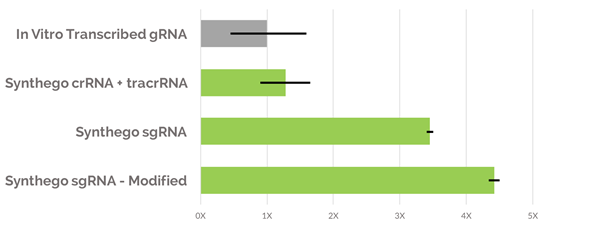An interview with Paul Dabrowski, CEO of Synthego, conducted by April Cashin-Garbutt, MA (Cantab)
What is synthetic single guide RNA (sgRNA) and why is it required for CRISPR genome editing?
Chemically synthesized single guide RNA is the best way to do CRISPR genome editing. It is more pure than biological methods of creating guide RNAs, like in vitro transcription or plasmids. As a result, sgRNA leads to more consistency and higher quality. Overall, this means less work for the researcher validating and reproducing results, and fewer repeats of experiments.
The significance of synthetic sgRNA for CRISPR includes the following:
- Higher editing efficiencies up to 4.4X over transcribed RNA
- More consistency between experiments
- 100% DNA-free (critical for CRISPR therapeutics, plant genomics)
- Can be chemically stabilized for difficult cell types such as stem cells
The chart below compares the editing efficiency (solid bars) and the consistency (black line) between experiments of Synthego’s synthetic RNA vs. in vitro transcribed RNA.

Traditionally how long did it take to produce sgRNA?
Prior to Synthego, the production of synthetic sgRNA was very difficult, costly and time consuming. The average price was significantly more than $1,000 and it could take several weeks to synthesize. In addition, it was very difficult to synthesize sgRNA lengths of 100-mer, and it required specialized purification to reach good quality.
With Synthego, the cost of sgRNA is down to $295 list price, and even lower for research institutions and volume purchases. Also, the turnaround time is days instead of weeks.
The table below compares Synthego sgRNA against two other providers.
_thumb.png)
How does Synthego’s synthetic sgRNA kit work?
Synthego offers sgRNA under the product brand CRISPRevolution. It comes in an EZ sgRNA Kit for CRISPR that arrives ready for transfection with no annealing required, thereby saving laboratory time and removing a potential source of error.
On arrival, the kit can be used to dissolve the lyophilized sgRNA so it can be duplexed with Cas9 nuclease to easily form a ribonucleoprotein (RNP) complex for immediate transfection.
The researcher simply orders the sgRNA on www.synthego.com by entering their target sequence per gene. Synthego then synthesizes the sgRNA and ships to the researcher, typically within 5 to 7 days.
The EZ sgRNA Kit includes:
- User defined 17-20nt target sequence
- 1 nmol; approx 10-20 transfections
- TE Buffer
- Nuclease-free water
- Optional Cas9
For a limited time, researchers can order free samples of the EZ sgRNA Kit at: www.synthego.com/free/
Custom (up to 100nt) and modified versions also available as an option.
What impact do you think Synthego’s synthetic sgRNA kit will have on research?
Synthego’s sgRNA Kit is making a huge impact in CRISPR research by making world-class tools available to all scientists, reducing the barriers to highly efficient and consistent gene editing experiments for the first time. Synthego has broken the price barrier of sgRNA while maintaining a high level of quality.
Since the public launch in August 2016, Synthego is already shipping the CRISPRevolution product line, consisting of both sgRNA and cr:tracrRNA to 31 countries, including 9 of the world’s top 10 life sciences universities.
Can you please give some examples of researchers that are currently using Synthego’s sgRNA kit?
Seattle Children’s Research Institute is currently using Synthego’s sgRNA kit to find a cure for pediatric hemoglobinopathies and immune deficiency diseases, and researchers at the University of California, Berkeley, Patel Lab are also using the kit for several research projects.
What feedback have you received so far?
The feedback from all of our customers has been very positive, with many of them stating they have been able to do research that was otherwise difficult or inconsistent. Others have saved valuable time and money in the lab due to the convenience of our kits.
For example, Seattle Children’s and UC Berkeley have also specifically mentioned the very high editing efficiencies, up to 90 percent, they have achieved with Synthego’s product, as opposed to the 20 percent they were seeing with other reagents.
What advances are in the pipeline?
As the CRISPR market advances, therapeutics will be a growing area. That will then drive demand for higher quality, therapeutics-grade products.
Our long-term vision is to enable every scientist to conduct highly efficient and consistent experiments at a rapid rate. To this end, Synthego envisions a “laboratory in the cloud” that allows any scientist to conduct massive experiments at a reasonable cost.
What do you think the future holds for genome editing?
By the year 2050, the world’s population will grow to nearly 10 billion, according to the United Nations. This means that we will need to find ways of improving healthcare, energy and environmental sustainability, and food supply.
CRISPR genome editing holds the key to much of our future revolving around drug discovery and personalized medicine. For example, there are several healthcare areas where huge gains can be made, including immunotherapies to target cancer and cures for both inherited and communicable diseases.
Further, the world’s food supply may be improved in safer, better understood ways instead of current methods for creating genetically modified organisms.
In the future, biofuels and bioenergy will also be available at competitive costs, in addition to engineered organisms that create a new materials and even help with garbage disposal and degradation of waste products.
We dream of a world that is healthier, cleaner and safer for everyone.
Where can readers find more information?
Readers interested in more information about Synthego can visit: www.synthego.com.
About Paul Dabrowski
 As CEO and co-founder of Synthego, Paul led the company from inception through its next-generation engineering phase, and to its world-class commercial offering for genome engineering.
As CEO and co-founder of Synthego, Paul led the company from inception through its next-generation engineering phase, and to its world-class commercial offering for genome engineering.
Prior to Synthego, Paul was the lead digital designer for the Falcon 9 rocket and Dragon spacecraft at SpaceX.
Paul also founded ventures in mobile software and consumer accessories, as well as having designed a desktop-size electron microscope for DNA sequencing at Halcyon Molecular.
Paul earned his MS in EE and BS in Computer Engineering from the University of Illinois at Urbana-Champaign.